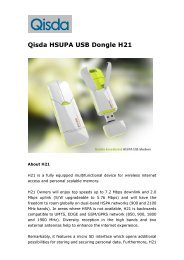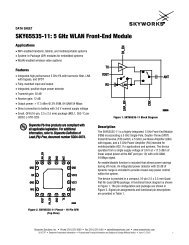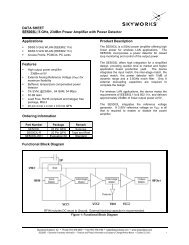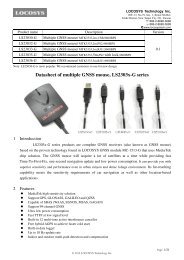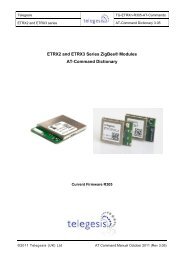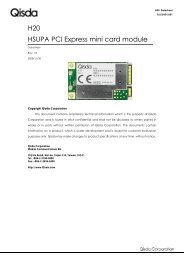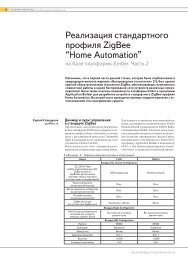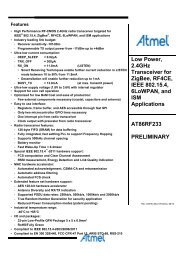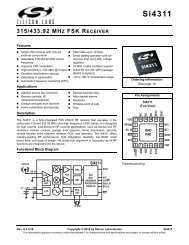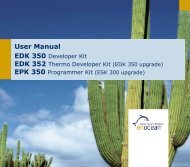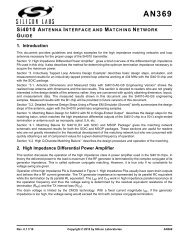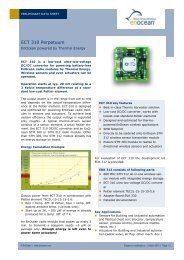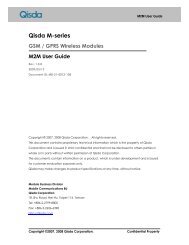AT Command Reference Guide for EDGE Wireless ... - wless.ru
AT Command Reference Guide for EDGE Wireless ... - wless.ru
AT Command Reference Guide for EDGE Wireless ... - wless.ru
You also want an ePaper? Increase the reach of your titles
YUMPU automatically turns print PDFs into web optimized ePapers that Google loves.
Chapter 11 – GPRS <strong>Command</strong>s<br />
11.5 <strong>AT</strong>+CGD<strong>AT</strong>A Enter Data State<br />
Description: The test command is used <strong>for</strong> requesting in<strong>for</strong>mation on the supported layer 2 protocols to be<br />
used between the TE and MT.<br />
The write command causes the MT to per<strong>for</strong>m all actions which are necessary to establish<br />
communication between the TE and the network using one or more GPRS PDP types. This may<br />
include per<strong>for</strong>ming a GPRS attach and one or more PDP context activations. <strong>Command</strong>s<br />
following the <strong>AT</strong>+CGD<strong>AT</strong>A command in the <strong>AT</strong> command line will not be processed by the MT.<br />
If no is given or if there is no matching context definition, the MT will attempt to activate the<br />
context with PDP type IP and all other context parameters set to their default values (see<br />
<strong>AT</strong>+CGDCONT, <strong>AT</strong>+CGQREQ, <strong>AT</strong>+CGQMIN).<br />
If the parameter is omitted, the layer 2 protocol is unspecified and PPP will be used.<br />
If the write command is successful, the MT issues the intermediate result code CONNECT and<br />
enters V.250 online data state.<br />
After data transfer is complete and the layer 2 protocol termination procedure has completed<br />
successfully, the command state is reentered and the MT returns the final result code OK.<br />
If the parameter value is unacceptable to the MT, the MT returns ERROR or +CME<br />
ERROR.<br />
In the event of erroneous termination or a failure to start up, the command state is reentered and<br />
the MT returns NO CARRIER, or if enabled +CME ERROR.<br />
Test <strong>Command</strong> Syntax: <strong>AT</strong>+CGD<strong>AT</strong>A=<br />
Response:<br />
+CGD<strong>AT</strong>A: (list of supported s)<br />
OK<br />
Write <strong>Command</strong> Syntax: <strong>AT</strong>+CGD<strong>AT</strong>A=[[, [, [,... ]]]]<br />
Response:<br />
CONNECT<br />
NO CARRIER<br />
ERROR<br />
+CME ERROR<br />
Parameter Descriptions:<br />
<br />
Layer 2 protocol to be used between the TE and MT.<br />
“PPP“ layer 2 protocol PPP. Default.<br />
<br />
Parameter specifies a particular PDP context definition. The parameter is local to the TE-MT interface and is<br />
used in other PDP context-related commands.<br />
1...2<br />
Notes:<br />
• If the MT is in dedicated mode, write command returns “+CME ERROR: operation temporary not allowed”.<br />
• It is possible to leave the GPRS data mode and enter the command mode by using the V.250 command +++.<br />
By using the command <strong>AT</strong>+CGD<strong>AT</strong>A again, the data mode is reentered. Which context is used to return to data<br />
mode, depends on the supplied parameter .<br />
If no is specified, this is equivalent to using the V.250 command <strong>AT</strong>O, which is usable <strong>for</strong> GPRS<br />
connections too. In this case the first context will be used, which is active and already in data mode since it has<br />
been activated.<br />
It is possible to use <strong>AT</strong>+CGD<strong>AT</strong>A to enter the data mode <strong>for</strong> a context, which is not yet in data mode since it has<br />
been activated. With <strong>AT</strong>O this is not possible.<br />
11.5.1 Automatic Deactivation of PDP Context During Dial-up PPP<br />
When using the <strong>AT</strong>+CGD<strong>AT</strong>A write command or <strong>AT</strong>D*99# or <strong>AT</strong>D*98# the MT issues the intermediate result<br />
code CONNECT and enters V.250ter online data state. In V.250 online data state, first some LCP protocol<br />
exchange between MT and TE is per<strong>for</strong>med to set up the PPP link. After successfully establishing the PPP<br />
link, the MT per<strong>for</strong>ms the PDP context activation procedure if the context is not already activated. As a<br />
result, the MT is in a “PDP context activated” state within the PLMN, the PPP link is established on the<br />
mobile side and the mobile is ready <strong>for</strong> IP data transfer.<br />
If the TE wants to close the LCP link the MT may per<strong>for</strong>m an LCP termination request procedure on PPP<br />
level.<br />
After this LCP termination procedure the MT deactivates the PDP context automatically and the MT returns<br />
to V.250 command mode and issues the final result code NO CARRIER.<br />
During the implicit PDP context deactivation procedure after LCP termination the TE may change into V.250<br />
command state (e.g., by using +++ or by toggling DTR if <strong>AT</strong>&D is set to 1) be<strong>for</strong>e the result NO CARRIER<br />
occurs.<br />
In this case the application should not try to deactivate the PDP context by using the commands <strong>AT</strong>+CGACT<br />
or <strong>AT</strong>H. If DTR is configured to disconnect data connections (<strong>AT</strong>&D2), then the application should not toggle<br />
DTR during the implicit PDP context deactivation and be<strong>for</strong>e “NO CARRIER” is received.<br />
Multi-Tech Systems, Inc. <strong>AT</strong> <strong>Command</strong>s <strong>for</strong> <strong>EDGE</strong> Modems (S000371B) 147



